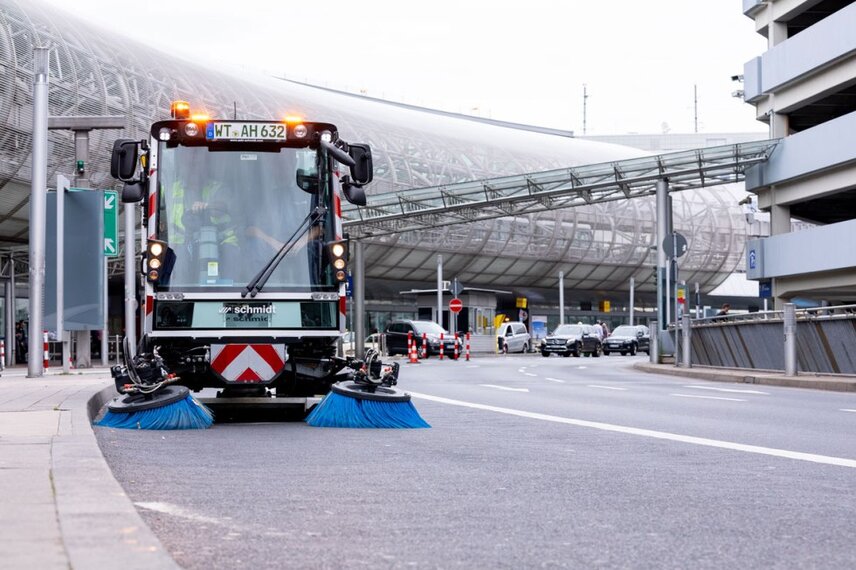Aebi Schmidt had the opportunity to interview Helmut Didschun, Operations Manager of the Düsseldorf Airport maintenance depot, and Martin Ideler, Head of Vehicle Management at Düsseldorf Airport, while they were staying at our St. Blasien plant for operation acceptance – still for a conventional model. Five compact sweepers operate a double shift at Düsseldorf Airport every day, both airside and landside, as required. While the large sweepers clean the runways, the compact machines are out and about primarily on the apron. ‘There are over 90 waste and FOD bins along the length of the terminal alone,’ says Helmut Didschun, adding that the bigger challenge is actually clearing the litter dropped by passengers, particularly the scraps of paper left around the cargo and baggage conveyors: «There are numerous places that a large AS990 just can’t reach.» We already learned about the great importance of cleanliness at the airport from Helmut Didschun in this blog post four years ago. «We also use the machines in heavy rain, either to suck up the water or to work in combination with the large machines when sucking up glycol. A big advantage here is that we can discharge the collected water directly and don’t need to tip it out,» says Didschun.
![From left: Ünal Yangin, Rüdiger Burs, Helmut Didschun, Martin Ideler [Photo: Andreas Wiese Fotografie, D-40479 Düsseldorf]](/CMS/Blog/2019/11-eswingo%20200-%20flughafen/20178/image-thumb__20178__is-8-width/eswingo_dus_2_web.jpg)
Significantly higher wear of the machines
The machines are consistently operated on a double shift and at the airport – in contrast to most municipalities – there are hardly any access roads used purely for driving. This means that the operating hours and therefore also the wear of the machines is significantly higher at the airport. «At the airport, special operations like sucking up water or picking up binding agents are more frequent and more diverse than in municipalities,» adds Martin Ideler. Ideler knows what he’s talking about, as he worked in the municipal sector before getting his current job at the airport. «In the municipal sector, a special-purpose vehicle is often used for specific operations. For operational reasons, we can’t afford to do that at the airport. Here, we need to be able to respond much more quickly and effectively,» says Ideler.
Electric drive enables more productive use
Düsseldorf Airport can look back on almost 20 years of experience working with compact sweepers. Once Helmut Didschun’s team had the opportunity to test the electric model, the thing they were most impressed by, in terms of operational processes, was that trips to fill up the fuel tank were eliminated. The 60-litre tank on the conventional diesel model is usually sufficient to cover both shifts. However, the airport filling station is not close to where the vehicles park up, as it is at a municipal depot, for example. Due to safety precautions at the airport, vehicles have to drive to filling stations that are located far away from where the sweepers are used. «A trip to fill up loses us a good half an hour of otherwise productive time,» says Helmut Didschun. «But electricity, in contrast, is available in many operational areas, so the vehicle or battery can be charged directly where it is parked or in use, even over lunchtime, without extra journeys to the filling station,» explains Ideler, also pointing out that you are not permitted to drive in the safety zones with a full hopper. This is yet more time that can be saved by using the electric model.
Lower TCO is relevant, but not the only economic driver
As Düsseldorf Airport explained in their press release (available in German), it is not only environmental factors – the airport wants to halve its CO2 emissions by 2030 – but also economic factors that play a role in deciding to invest in electric vehicles. «Our expectation is very clear: maintenance costs must be reduced, i.e. there will be fewer visits to the workshop. Just like the manufacturers promise,» says Martin Ideler. However, Ideler also explains that while TCO is a relevant criterion, the empirical values needed for making an exact calculation and comparison are still lacking. That is why the airport decided to test a vehicle in continuous use first. For the Operations Manager, however, there is another key factor to consider – one which is difficult to quantify, but which experience shows is extremely important: «In addition to the higher workload, many other special operational issues arise here, for which we have made adjustments on the vehicle or in the process in recent years. Being able to continue using the experience gained over the years and not have to start again from scratch now with the electric model plays a vital role and saves a lot of time and money.» This also includes the reduced training outlay for drivers. With only a few exceptions, they simply find themselves back in their familiar workspace.
A sense of anticipation for drivers
The airport fleet is already made up almost entirely of environmentally friendly vehicles. The sustainability strategy at Düsseldorf Airport also includes plans to expand the charging infrastructure in the coming years. In terms of sweepers, the airport wants to test a machine in continuous use before a decision is made about the next steps. In answer to the question about what exactly will be tested more intensively during continuous use, Helmut Didschun answers without hesitation: «Everything, of course!» Based on years of experience and following the initial test, Didschun is certain that the electric model will also prove itself, as it offers identical performance and the same comfort, with noise levels in particular being even better. «However,» says Didschun, «we now want to test that in practice and compare it with the figures and empirical values we have collected for the diesel model in recent years.» When asked whether his drivers were happy or sceptical about the new machine, Didschun replies again without hesitating: «They are definitely happy – even more so after the initial test drives.»



![[Photos: Andreas Wiese Fotografie, D-40479 Düsseldorf]](/CMS/Blog/2019/11-eswingo%20200-%20flughafen/20182/image-thumb__20182__is-8-width/eswingo_dus_6_web.jpg)
